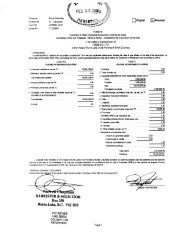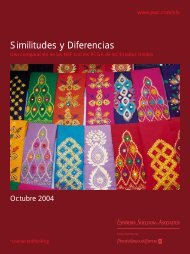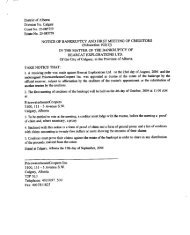TLS Newsletter 11 marzo 2011 - PwC
TLS Newsletter 11 marzo 2011 - PwC
TLS Newsletter 11 marzo 2011 - PwC
You also want an ePaper? Increase the reach of your titles
YUMPU automatically turns print PDFs into web optimized ePapers that Google loves.
Licenziamenti collettivi:<br />
meno vincoli se la riduzione del<br />
personale riguarda l’intero complesso<br />
aziendale<br />
(Luca Saglione – Erika Ferri)<br />
Con una recente pronuncia (n. 24343 del 1° dicembre<br />
2010), la Suprema Corte di Cassazione ha stabilito che,<br />
nella comunicazione alle Organizzazioni Sindacali di<br />
avvio della procedura di mobilità, il datore di lavoro può<br />
limitarsi ad indicare il numero complessivo dei lavoratori<br />
eccedenti.<br />
I fatti<br />
La vicenda su cui si è pronunciata la Cassazione è relativa<br />
ad una procedura di mobilità attivata da un istituto<br />
di credito al fine di ridurre i costi del lavoro dell’intero<br />
perimetro aziendale, prescindendo dalla collocazione<br />
dei dipendenti in esubero e dai loro profili professionali.<br />
Pertanto, la comunicazione sindacale di avvio della<br />
procedura di mobilità si limitava ad individuare il solo<br />
numero dei lavoratori in esubero.<br />
Quanto precede, nonostante la previsione dell’articolo<br />
4, Legge n. 223/1991, in forza del quale nella comunicazione<br />
di inizio procedura, il datore di lavoro deve, altresì,<br />
indicare espressamente la collocazione aziendale ed i<br />
profili professionali dei lavoratori in esubero.<br />
In seguito all’intimazione dei licenziamenti, a fronte<br />
dell’impugnazione stragiudiziale del recesso da parte di<br />
alcuni dipendenti, l’istituto di credito instaurava in via<br />
preventiva un giudizio al fine di vedere riconosciuta la<br />
legittimità del proprio comportamento, che veniva confermata<br />
dal Giudice di primo grado.<br />
Soltanto uno dei lavoratori impugnava la sentenza di<br />
primo grado dinnanzi alla Corte d’Appello di Torino la<br />
quale, a conclusione del giudizio, confermava la sentenza<br />
impugnata.<br />
La Suprema Corte ha confermato nuovamente la correttezza<br />
della procedura seguita dal datore di lavoro, “spianando<br />
la strada” ad un orientamento giurisprudenziale<br />
che vede alleggeriti i contenuti della comunicazione di<br />
avvio della procedura di mobilità.<br />
La decisione della Corte<br />
La Corte di Cassazione, nel definire la vertenza, è stata<br />
chiamata a decidere sulla completezza della comunicazione<br />
di inizio della procedura per i licenziamenti collettivi<br />
per riduzione del personale, tenendo conto di quanto previsto<br />
dall’articolo 4, comma 3, Legge n. 223/1991.<br />
In passato, la Suprema Corte era già stata chiamata a pronunciarsi<br />
sulla completezza della comunicazione ex articolo<br />
4, optando, però, per un’interpretazione più restrittiva dalla<br />
norma in questione.<br />
Collective Redundancy:<br />
Fewer constrains if the reduction<br />
of staff concerns the whole<br />
company<br />
(Luca Saglione- Erika Ferri)<br />
With a recent decision (no. 24343, December 1st 2010),<br />
the Supreme Court has ruled that, in the communication<br />
addressed to the Trade Unions to start a collective dismissal<br />
procedure, the employer can limit the information provided<br />
to the sole number of redundant workers.<br />
The facts<br />
The Supreme Court has ruled on a mobility procedure<br />
triggered by a Bank to reduce the labour costs of the entire<br />
perimeter of the Company, regardless of the location of the<br />
redundant staff and their professional profiles.<br />
Accordingly, the communication addressed to the Trade<br />
Unions to start a collective dismissal procedure, provided<br />
the sole number of redundant workers.<br />
The above, despite the provision of Article 4, Law No.<br />
223/1991, which provides that, in the information letter<br />
to the Trade Unions, the employer must also explicitly state<br />
the organizational and professional profiles of the workers<br />
made redundant.<br />
Following the refutation of the dismissals notified by some<br />
employees, the Bank claimed in order to have the compliance<br />
of its behavior recognized by the Court, behavior which<br />
was upheld by Judge of first instance.<br />
Only one of the workers appealed against the decision<br />
of first instance in front of the Court of Appeal of Turin,<br />
which, at the conclusion of the proceedings, confirmed the<br />
decision.<br />
The Supreme Court has once again confirmed the correctness<br />
of the procedure followed by the employer, “paving the<br />
way for” a case law aimed to lessen the compulsory contents<br />
of the communication to start the mobility procedure.<br />
The Court decision<br />
The Supreme Court, in defining the dispute, was required<br />
to decide on the completeness of the notice of commencement<br />
of the procedure for collective dismissals for staff<br />
reductions, taking into account the provisions of Article 4,<br />
paragraph 3 of Law No. 223/1991.<br />
In the past, the Supreme Court had already been asked to<br />
rule on the completeness of the Article 4, choosing, however,<br />
to follow a more restrictive interpretation of the rule in<br />
question.<br />
23 <strong>TLS</strong> <strong>Newsletter</strong> n° 3 Anno 20<strong>11</strong>
















